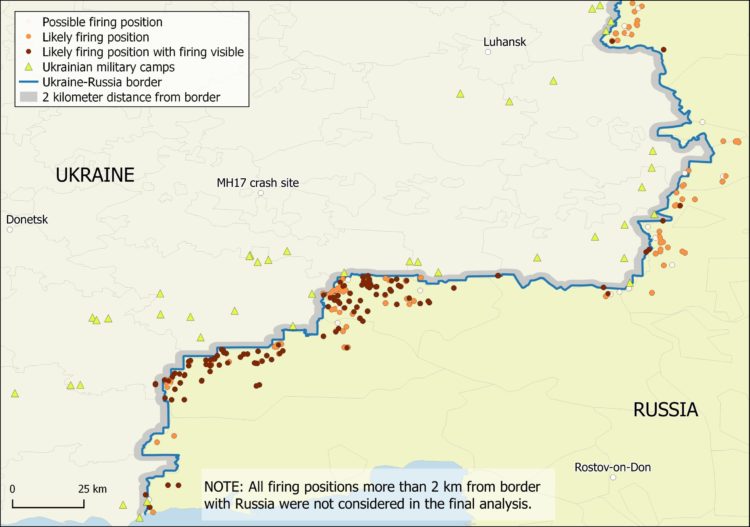Intercepts shared during the trial of MH17, a passenger airliner downed by a Russian anti-missile system on 17 July 2014, have revealed that the “rebels” of the “people’s republics” in eastern Ukraine regularly sent target lists for artillery strikes to the Russian military. This detail is a new vivid illustration of Russia’s, essentially, proxy war on Ukrainian land while claiming to the world that it is a “civil war.”

The regular court hearing in The Netherlands in the case of the downing of flight MH17 where these intercepts were shared took place on 17 June 2021 and was reported by the Ukrainian state media agency Ukrinform. The accusation prested an intercepted conversation between two accused, Sergey Dubinsky and Oleg Pulatov, held on 17 July 2014, the date when MH17 was downed, at 9:31 AM. On the intercept, Russian military intelligence GRU colonel Sergey Dubinsky tells his deputy, GRU lieutenant colonel Oleg Pulatov, that “Krot” (another accused in the case -- Leonid Kharchenko) will deliver the Buk-M and it will need to be placed in the vicinity of the Pervomaiske village.
During the conversation, Pulatov asks Dubinsky if he could launch an artillery strike from Russian territory at a group of Ukrainian military bases near Hryhorivka, a village of Donetsk Oblast in close proximity to the Ukrainian-Russian border.
“Pulatov also asks if the ‘eastern neighbor’ can arrange hell for the Ukrainian army near Hryhorivka, and Hryhorivka is a village behind Stepanivka, near the Ukrainian-Russian border. A number of other intercepted telephone conversations also contained requests from the ‘DNR’ for artillery support from the Russian side," public prosecutor Ward Ferdinandusse said.
Demonstrating a visual presentation on the conflict as of July 16, the prosecutor noted that at that time the Ukrainian side was advancing from Hryhorivka in the direction of Marynivka, Donetsk Oblast, in the immediate vicinity of the border with Russia.
"Many sources in the case claim that the DNR received combat support in the form of artillery fire from the territory of the Russian Federation," Ferdinanduse said, adding that Russia denies this.
The public prosecutor referred to reports by the Ukrainian Security Service and BBC about Ukrainian positions getting shelled bear Marynivka from Russian territory. He also referred to a report by Bellingcat, which established at least 136 Ukrainian sites that were shelled and 133 Russian sites from where the shelling was conducted.

He also told that the Dutch military investigation (MIVD) and the British analytical center RUSI also confirm Russian artillery strikes on Ukraine in July 2014.
Dr. Ferdinandusse said that the case contains information about artillery fire on Ukrainian positions from Russian territory and the prosecution considers it important in terms of assessing the intercepted negotiations and communication that existed at the time between the “Donetsk People’s Republic” (“DNR”) and Moscow.
In previous court hearings, prosecutors presented other intercepts pointing to Russia’s control over the so-called “republics” at the highest political level.
Namely, such intercepts showed that on 4 July 2014, Dubinsky was waiting for “Moscow’s decision” as to whether to withdraw from Sloviansk, a strategic city held by Russian-separatist forces. In another conversation, Russian military intelligence GRU colonel Igor Girkin, in the position of “DNR Defense Minister,” was said to have contacted Moscow, who wanted him to stay put in Sloviansk.
And on 3 July 2014, Putin’s top advisor Vladislav Surkov, said to the be the curator of the Russian-backed proxy statelets in Donbas, was heard
instructing the “Prime Minister” of the “DNR,” Russian citizen Aleksandr Borodai to admit his appointee to the post of “Minister of state security.” In other calls, Borodai admitted to following orders from Russia:
“I’m carrying out orders and protecting the interests of one and only state, the Russian Federation. That’s the bottom line,” he said.
In another call, dated 1 July 2014, a “DNR” member tells a local commander that men from a mandate from Russia’s Defense Minister Sergey Shoygu are coming to expel local warlords and replace them with “people from Moscow.”
Intercepted phone calls show MH17 suspects’ connections to Russian military and Kremlin
Passenger airliner MH17 was heading from Amsterdam to Kuala Lumpur when it suffered a catastrophe on the territory of temporarily occupied Ukrainian territory on 17 July 2014. All 283 passengers and 15 crew members on board died.
The Joint International Team (JIT) investigating the crash arrived at the conclusion that the plane was shot down from a Buk anti-aircraft missile launcher belonging to the Russian Army’s 53d anti-aircraft brigade from Kursk.
On 19 June 2019, JIT announced the names of four accused who are considered involved in transporting and military engagement of the Buk missile launcher. This is former FSB officer and so-called former Defense Minister of the “DNR” Igor Girkin (Strelkov), currently general and at the time, Russian military intelligence GRU colonel and “DNR GRU” chief Sergey Dubinsky, GRU lieutenant colonel Oleg Pulatov (all are Russian citizens), Ukrainian citizen Leonid Kharchenko, who fought on the side of the “DNR.”
The district court of The Hague started considering the case of the catastrophe of MH17 in March 2020.
Related:
- Intercepted phone calls show MH17 suspects’ connections to Russian military and Kremlin
- Bellingcat IDs GRU agent for occupied Donetsk and possible MH17 witness
- MH17 intercepts prove Moscow pulled all the strings in belligerent east Ukraine statelets

